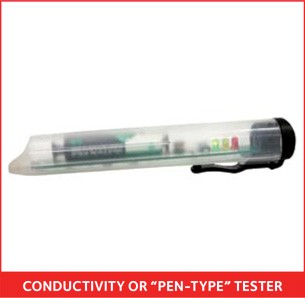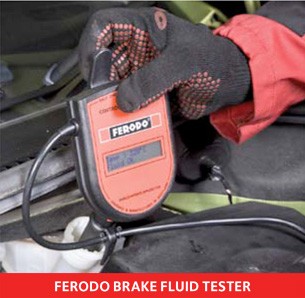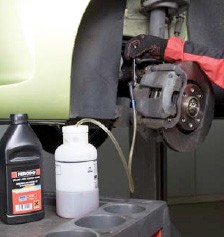Drivers can experience loss of braking efficiency in different ways: overheating, brake fade and brake pad degradation are just a few. ‘Vapour lock’ and ‘spongy pedal feel’ are serious brake efficiency issues and here we bring you our in-depth advice.
A. VAPOUR LOCK
One of the most frightening and dangerous losses of braking efficiency, vapour lock is connected with brake fluid. Braking generates considerable heat and to resist these high temperatures without boiling, brake fluid is designed with a high boiling point. But brake fluid is also hygroscopic, which means it absorbs water. In any hydraulic brake system, the brake fluid gradually absorbs moisture and this reduces the brake fluid’s boiling point.
Once this moisture absorption reaches a certain level – under prolonged, hard braking, especially in hot weather or heavy loads – the heat can cause the brake fluid to start to boil, creating gas bubbles. As gas is far more compressible than liquid, the driver will experience no pressure at all on the brake pedal, resulting in total loss of brake power known as vapour lock.
HOW TO AVOID VAPOUR LOCK
1. CHOOSE THE RIGHT BRAKE FLUID
The brake fluid you choose to put in the hydraulic system is critical. Vehicle manufacturers recommend a specific type and this should always be adhered to. Of course, the quality of the brake fluid is key. Below are some features to look for.
A good fluid should :
- be incompressible to give solid pedal during braking
- have a high boiling point
- maintain performance during absorption of moisture
- have a viscosity that remains within closely defined parameters
- have the correct level of lubricity
- prevent corrosion
- have a controlled rubber swell to prevent shrinkage.
Ferodo brake fluids have all these important attributes and exceed legal requirements across the entire range.
2. TEST THE BRAKE FLUID
Although many vehicle and brake manufacturers give minimum recommendations, the right time to change the brake fluid should not be based on the vehicle’s mileage or age. The only real way to know is to test the brake fluid by boiling it. Here are some points to bear in mind:

Conductivity or ‘pen-type’ testers do not boil the fluid. They estimate the water content electronically. In theory, conductivity (and/or capacitance) increases with moisture content, but be warned that these testers can potentially ‘fail’ new fluid and ‘pass’ contaminated fluid.

Ferodo has developed a high quality brake fluid tester (part number FFT100A). The Ferodo brake fluid tester ensures you can accurately measure brake fluid for your customers. In cases where customers require totally accurate water content, Ferodo can determine it by using industry standard techniques such as the well-known Karl Fisher method for water content.
3. CHANGE THE BRAKE FLUID
You must change the brake fluid when the boiling point is too low. Here are our guidelines on bleeding the system in order to change the fluid.
Caution: Before bleeding the system, carry out a master cylinder leak pass test by attaching a pressure gauge to the closest caliper brake pipe.
The system must be pressurised to 50 bar for 45 seconds, during which time there should be no more than a 4 bar loss of pressure. Any further drop indicates a master cylinder leak pass, which needs attention. A second check can also be carried out, but at a lower pressure of 10 bar.
BLEEDING PROCESS – VEHICLES WITH FRONT AND REAR DISC BRAKES
Always bleed brakes in a set order, starting with the brake caliper furthest from the master cylinder (either left-rear or right-rear dependant i.e. left-hand or right-hand drive).
- With all bleed nipples closed, fit a bleed pipe to the first caliper and loosen the nipple.
- Using slow, full and firm strokes of the brake pedal continue until the brake fluid is visually (in the bleed pipe) clean, and clear of air bubbles.
- With the pedal fully depressed tighten the bleed nipple, and remove the bleed pipe.
- Continue to the opposite rear caliper and repeat the procedure.
- After completing the rear calipers make certain the front calipers are also properly functioning and free of air bubbles by bleeding the front calipers starting also furthest from the master cylinder, and finishing closest to the master cylinder.
- Finally ensure that an adequate pedal pressure is achieved.

BLEEDING PROCESS – VEHICLES WITH DRUM BRAKES
Always bleed brakes in a set order, starting with the wheel point furthest from the master cylinder (either left-rear or right-rear dependent i.e. left-hand or right-hand drive).
Before starting the bleeding process, it’s essential to ensure the correct manual adjustment (if present) is carried out on the brake shoes to brake drum clearance, according to the manufacturer’s specifications.
- With all bleed nipples closed, fit a bleed pipe to the bleed nipple, of the wheel cylinder furthest from the master cylinder and loosen the nipple.
- Using slow, full and firm strokes of the brake pedal, continue until the brake fluid is visually (in the bleed pipe) clean, and clear of air bubbles. > With the pedal fully depressed tighten the bleed nipple, and remove the bleed pipe.
- Continue to the opposite rear wheel cylinder and repeat the procedure.
- After completing the rear wheel cylinders, make sure the front calipers are also properly functioning and free of air bubbles by bleeding the front calipers (starting with the furthest and finishing with the closest to the master cylinder).
- Finally, ensure that an adequate pedal pressure is achieved.
B. SPONGY PEDAL FEEL
This is experienced when the brakes are slow to respond, with a spongy (softer than it should be) pedal feel, and excessive force required to slow the vehicle.
WHAT CAUSES SPONGY PEDAL FEEL AND HOW CAN YOU FIX IT?
Faulty brake hoses can often cause brake fluid leaks, or ballooning of the hose itself, which in turn means a poor brake pedal response.
HOW TO AVOID FAULTY BRAKE HOSES
1. AGING: check regularly for chaffing, cuts, general deterioration and leakage.
2. FITMENT: ensure it is not bent or twisted, the correct tightening torque is applied and there is no contact between hoses and suspension components once vehicle has been lowered.
3. QUALITY: choose hoses that show high resistance, good flexibility, low moisture permeability and low volume expansion under pressure. Ferodo offers a comprehensive range of high quality brake hoses that is continually growing to meet market needs.